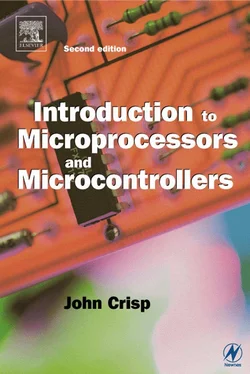John Crisp - Introduction to Microprocessors and Microcontrollers
Здесь есть возможность читать онлайн «John Crisp - Introduction to Microprocessors and Microcontrollers» весь текст электронной книги совершенно бесплатно (целиком полную версию без сокращений). В некоторых случаях можно слушать аудио, скачать через торрент в формате fb2 и присутствует краткое содержание. Год выпуска: 2004, ISBN: 2004, Издательство: Elsevier, Жанр: Компьютерное железо, на английском языке. Описание произведения, (предисловие) а так же отзывы посетителей доступны на портале библиотеки ЛибКат.
- Название:Introduction to Microprocessors and Microcontrollers
- Автор:
- Издательство:Elsevier
- Жанр:
- Год:2004
- ISBN:0-7506-5989-0
- Рейтинг книги:3 / 5. Голосов: 1
-
Избранное:Добавить в избранное
- Отзывы:
-
Ваша оценка:
- 60
- 1
- 2
- 3
- 4
- 5
Introduction to Microprocessors and Microcontrollers: краткое содержание, описание и аннотация
Предлагаем к чтению аннотацию, описание, краткое содержание или предисловие (зависит от того, что написал сам автор книги «Introduction to Microprocessors and Microcontrollers»). Если вы не нашли необходимую информацию о книге — напишите в комментариях, мы постараемся отыскать её.
Introduction to Microprocessors and Microcontrollers — читать онлайн бесплатно полную книгу (весь текст) целиком
Ниже представлен текст книги, разбитый по страницам. Система сохранения места последней прочитанной страницы, позволяет с удобством читать онлайн бесплатно книгу «Introduction to Microprocessors and Microcontrollers», без необходимости каждый раз заново искать на чём Вы остановились. Поставьте закладку, и сможете в любой момент перейти на страницу, на которой закончили чтение.
Интервал:
Закладка:
This is a lot more difficult than we think because the developers of microprocessors are in competition with each other so as soon as a method is suggested, they try to exploit the situation to present their microprocessor as faster than all the others.
Be wary when reading comparisons – which tests have they chosen, and why? While watching the last Olympic games, it occurred to me that I was probably faster that any of those competing in the 100 metres. Yes, I felt confident that I could build a working microprocessor-based system quicker than any of the athletes. You see, comparisons all depend on the test that we have decided to use. Anyone can be World champion. It’s only a matter of choosing the tests well enough. With that in mind, here are a few popular speed comparisons.
MIPS (millions of instructions per second)
This appears an easy measurement to take. It is simply a matter of multiplying the number of clock cycles in a second by the clock cycles taken to complete an instruction.
The current Athlon for example can run at 2 GHz or 2000 MHz. It can perform up to 9 instructions per clock cycle so its number of instructions per second is simply 2×10 9×9=18 000 million cycles per second.
Life is never that simple. Some instructions are more time consuming than others as they take a different number of clock cycles to perform the task. Competitors will obviously choose instructions that give the most impressive results on their own microprocessor.
An extreme example occurred about ten years ago with the Intel 80836, we could ask it to perform some additions. By consulting the instruction set, we could see that they each take two clock cycles to complete. Now, if we take a clock frequency of 25 MHz, each clock cycle would last for 40 ns so an ‘add’ instruction would take 80 ns. This would equate to a speed of 12.5 MIPS. An unkind competitor may take ‘at random’ the divide instruction that takes 46 clock cycles, they could reduce its MIPS rating to a measly 0.54 MIPS. A really vindictive person could search through the instruction set with a magnifying glass and find that there is a really obscure instruction that takes 316 clock cycles. This would provide a speed of 0.08 MIPS – about the same as a four-bit microprocessor.
We cannot even say that we can make it fair by using the same instruction for each microprocessor since they don’t always have their talents in the same area. If we had two microprocessors, each with a ‘load’ instruction taking five clock cycles and they both ran on a 10 MHz clock, what would be their speed? 10/5 = 2 MIPS. (In working this out we can just ignore the fact that the clock cycle is in megahertz since the speed is measured in millions of instructions.) But can they do the job at the same speed? Possibly or possibly not. What if one was a 64-bit microprocessor and the other was an 8-bit microprocessor. The 64-bit one could shovel data at eight times the speed. For good reason MIPS have been referred to as ‘Meaningless Indication of Performance by Sales reps’.
To overcome the problem of which instructions should be employed some standard floating-point operations can be used.
As a quick reminder, a floating point number is one in which we have moved the decimal point to the start of the number, so 123.456 would be converted to 1.23456×10². This makes the mathematics faster. Modern microprocessors would have values in the order of ten GFLOPS (GigaFLOPS).
This also meets with objections. The obvious question is, ‘What “operation” is being measured?’ Choose your operation carefully and the opposition is left far behind.
Both of these tests, MIPS and FLOPS are supposed to be microprocessor tests and not system tests.
System tests
Other speed measurements tend to be system tests rather than microprocessor tests but a brief overview may be in order since they are often quoted, almost as alternatives.
Benchmarks
These tests are based on making the microprocessor-based system run a standard or ‘benchmark’ program. The immediate failing here is that to get a program to run on microprocessors with incompatible code will mean that the compilers will also be tested, which is not part of the system. There is also an immediate outcry from people who disagree with the program chosen since it doesn’t suit their system.
I/O operations (input/output operations)
As the name suggests, this measures the speed of accepting information in and sending it out again. But loading information from a CD for example will depend on whether the information is being read from the same track or does the head have to move and include seektime?
TPS (Transactions Per Second)
This is a move to model the tasks set into real-life situations. It requires the system to take in information, modify it and then store it again. It puts a heavy significance on memory access times and compilers.
SPECmark (Systems Performance Evaluation Co-operative’s benchmark)
This is the average result of carrying out 10 agreed benchmark tests in an attempt to measure the system performance in a range of situations. Recent changes include one using floating point arithmetic, which is of more interest to serious number crunching in science and engineering and the other an integer test for the rest of us. These are referred to as SPECfp95 and SPECint95. As a starting point for comparison, the 200 MHz Intel Pentium Pro delivers a value of 8.71 using the SPECint95.
Increase the clock speed
This seems the obvious answer and generating the necessary square wave shown in Figure 6.4 is no problem. In a modern microprocessor-based system there are two clocks that we need to consider. There is a square-wave clock that controls the internal operation of the microprocessor. This is the headline speed seen in the adverts, ‘the 2 GHz Pentium’. There is also the operating clock, about 133 MHz, for the system to control the external devices and memory. This saves us from upgrading all the external devices to match each new processor.
Internal clock speeds will probably continue to increase at least into the low gigahertz range but there are limiting factors that will make continuous increases in speed difficult to achieve. It would be a trivial electronic problem to generate a square wave of 1000 GHz or more, so there is obviously more to it. And there is.
Power dissipation
Heat is a form of power and is an unwanted by-product of any activity inside a microprocessor.
Power = voltage × current
So, to reduce heat production, we have to reduce either the voltage or the current, or both.
We will start with voltage since it is a little more straightforward. The early microprocessors used a 15 V supply that has been steadily reduced and the latest designs are pushing at 1.5 V. How much further can we go along this line? It appears as if we have nearly reached the limit. The integrated circuits are made from a semiconductor called silicon. This passes electricity under the control of electric charges. The applied voltage creates this charge. In silicon, the simplest device needs at least 0.6 V to operate although, by adding minute traces of other materials, this figure can be reduced a little. A single transistor can do little with voltages less than 1 V so in a complex circuit it is already amazing that the total voltages can be as low as they are. The chances of a microprocessor running on less than 1 V is slight indeed. If I were braver, I would say impossible. Another point with regard to the voltage is that we must not forget the effects of random electrical noise as we saw earlier in Figure 2.2. Sudden changes in current flow in nearby circuits can cause random changes. If the voltages are reduced too far, the microprocessor will become more prone to random errors.
Читать дальшеИнтервал:
Закладка:
Похожие книги на «Introduction to Microprocessors and Microcontrollers»
Представляем Вашему вниманию похожие книги на «Introduction to Microprocessors and Microcontrollers» списком для выбора. Мы отобрали схожую по названию и смыслу литературу в надежде предоставить читателям больше вариантов отыскать новые, интересные, ещё непрочитанные произведения.
Обсуждение, отзывы о книге «Introduction to Microprocessors and Microcontrollers» и просто собственные мнения читателей. Оставьте ваши комментарии, напишите, что Вы думаете о произведении, его смысле или главных героях. Укажите что конкретно понравилось, а что нет, и почему Вы так считаете.












